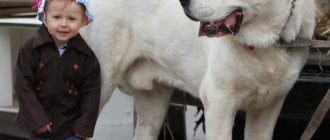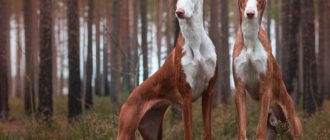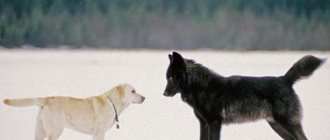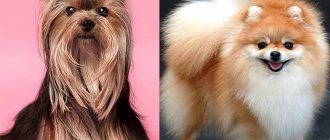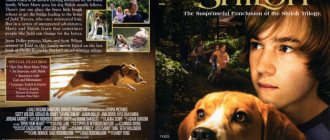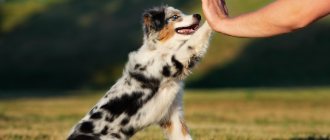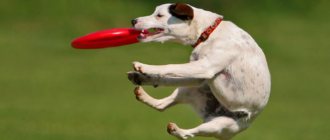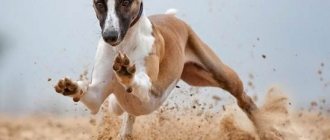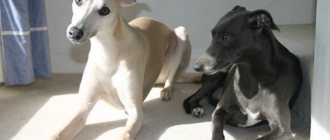Humanity loves dogs for many virtues - loyalty, dedication and constant positivity. But four-legged friends have one more quality that people needed to survive. The fastest dog in the world and representatives of its breed have saved human lives many times. And it was never a bad idea to catch game for food.
Therefore, the fastest dogs can be considered real guardian angels of humans. And they definitely deserve the monuments that will be discussed below!
Hungarian Vizsla – 60 km/h (record – 64 km/h)
The Hungarian Cops are very different in appearance from the other finalists. Vizslas are very muscular, strongly built dogs with a wide, proportional skull. Unpretentious to care for, but very sociable animals are loved by many people. Vizslas are one of the 10 fastest dogs: their speed can exceed 60 km/h!
Whippet
From its appearance it is immediately clear that the Whippet is a born runner. Long hind limbs and a muscular body help develop dynamics of up to 60 km/h.
Whippet
The Whippet is extremely sensitive. They subtly sense the emotional situation. Due to rough treatment, he can become very upset and even get sick. Therefore, when training, you cannot use physical methods of influence.
The Whippet is a loyal creature that gets along well with all family members. Loves affection and attention from the owner. In addition, he has high intelligence and rarely shows aggression.
Saluki
The second place is occupied by the Persian greyhound, or as it is also called - Saluki. She is not much inferior to the leader. The running speed is 67 km/h. At the same time, the animal is famous for its endurance and is able to run for 3-5 hours.
Saluki
The breed has existed for 5 thousand years. Salukis were kept in ancient Egypt. Archaeological artifacts bear an image of this four-legged pet. At home they get along with other pets. They love children and are friendly. In addition, she is clean and not whimsical.
Greyhound
The champion dog runner is the Greyhound. They are capable of accelerating up to 70 km/h. The athletic build and muscular limbs allow you to quickly cover short distances.
Greyhound
He is not capable of running marathons. The Greyhound quickly gets tired and loses momentum. The history of the species goes back to 3,000 BC. At home, the animal behaves calmly. They can even be kept in an apartment.
Border Collie
Initially, the breed is considered a herding breed, so at the genetic level the ability to move quickly and control everything is inherent. Running speed varies within 48 km/h.
Border Collie
Due to its good-natured nature, the border collie has gained popularity. The animal is easy to train. In one day, a dog can learn up to three commands.
Peculiarities:
- unpretentiousness;
- friendly attitude towards children;
- devotion;
- learning ability
Dalmatian
Dalmatian It would seem that Dalmatians were bred solely for beauty; their spotted coloring is visible from afar and immediately lifts the mood. However, the speed qualities of the motley black and white dogs are impressive - Dalmatians easily reach 60 km per hour , ahead of greyhounds. The breed has ancient historical roots, with the first paintings of Dalmatians dating back to the 1600s. They were bred for protection and simply as companions, and they needed speed to keep up with the carriage in which the owner was riding.
Dalmatians and horses
After all, on the way he can be attacked, and dog protection has always been highly valued! Today, Dalmatians remain devoted guards and friends of humans; the breed is assessed as human-oriented, however, such a dog should be trained from puppyhood, because they are sometimes prone to amateur activities and are overly independent. But if they treat themselves properly, these dogs get along with children and other pets and communicate a lot with their owners. They are short-haired, born pure white, and grow up to 60 cm as adults.
Jack Russell Terriers
Jack Russell Terrier
Small Russell Terriers are extremely energetic, they do not get along well as lap dogs, despite the fact that they grow only up to 25 - 35 cm. This is natural, because they were bred to hunt foxes, and even their white color is not accidental . After all, a hunter needs a dog that will be different from the game at first glance. Small but tightly built dogs can catch up and slightly outpace Dalmatians, reaching a speed of 61 km per hour . The breed can be short-haired or long-haired.
Russian canine
It so happened that in Russia, since ancient times, hunting has been held in high esteem by nobles and landowners. Therefore, it is not surprising that at the turn of the 10th century, almost every kennel had representatives of this breed.
The modern greyhound is a symbiosis of European and Asian elements. The European trait is revealed immediately when looking at the dog, but the Asian trait is expressed in the specifics of its character.
Although admittedly this breed is not one of the fastest, their talent for running at fantastic speed over short distances has been appreciated by many hunters. Running speed can reach 57 km/h .
The Russian dog is characterized by an elegant and narrow body combined with a fairly tall stature. Slightly elongated eyes are located on an elongated head, which is crowned with small, pointed ears that fit tightly to the neck. The presence of a thin and fairly long, saber-shaped tail makes the dog easily recognizable.
Description of the Russian Greyhound breed
Representatives of this species are thoroughly imbued with aristocracy. Tall dogs with a strong, dry body, slightly elongated. The long body turns into a long nose, gradually tapering. As a result, we observe a strict rectangular body shape.
Appearance
The narrow long head adds a special elegance to the appearance of the animal. Large expressive almond-shaped eyes of dark color make the look friendly and intelligent. The nose is large compared to the entire head. It protrudes forward above the lower jaw. Well developed teeth have a scissor bite.
The high, but not very wide apart, small ears bend back in a calm state and only when the greyhound is excited, for example, when it notices prey, do they straighten out. The long tail is densely covered with hair. The front legs are straight, muscular, and widely spaced. The hind ones are distinguished by their elongated oval shape and are spaced somewhat narrower than the front ones.
Weight and height
Height at the withers reaches 70-85 cm in males and 65-78 cm in females. The maximum weight reaches 48 kg. The stomach is strongly retracted, and the back is extended in the shape of an arc. This anatomy provides high running speed and unsurpassed hunting qualities.
Color and coat
The silky, slightly wavy dog's body fits tightly to the slender body. Only in the head area does the hair become shorter and denser.
The color of the coat of the Russian greyhound can be varied: white, grayish, even burmat color with a dark coating or red with black hair. The darker the color, the darker the mask on the animal's face.
Greyhound – record: 67 km/h
Greyhounds are absolute record holders for speed. The fastest dog reaches a speed of over 65 km/h! These hounds were brought from Eastern Europe to Great Britain, where they became an independent breed. Greyhounds were bred not only for hunting, but also for greyhound racing. These dogs are very elegant, smart and neat, they love walks, games and communication with the owner, whose words they understand well.
Attention! The absolute speed record for pets was recorded in 1994 at a race in Australia. The fastest dog, a hound dog from Great Britain named Star Title, was able to reach a speed of 67.32 km/h!
The fastest dog breed in the world
Greyhound
The fastest dog breed in the world is the Greyhound . The Eastern European hunter, brought to the UK, can reach speeds of up to 72 kilometers per hour ! The breed uses its natural skills both in hunting and in a unique sporting activity – greyhound racing. Dogs are distinguished by their aristocracy and ability to present themselves, communicate well with people, and are distinguished by their intelligence. They grow up to 70 cm tall, can weigh up to 40 kg, have a small head, thin neck and thin body. There are many colors, there are more than 30 of them.
Thus, hounds are actually the fastest hunting dogs. This is natural, because pursuing prey requires the dog to have high speed qualities, as well as decent mental abilities, the ability to work in a pack and understand people. Dogs from the listed breeds should not be taken for home if you want a calm indoor companion, but if you like long walks and are ready to devote time to playing with your pet, and even more so, if you live outside the city and are fond of hunting, then it would simply be better not to have a partner find!
Husky
This sled dog. The running intensity reaches 55 km/h. Huskies are prized in Alaska for their endurance and speed.
Husky
The animal is capable of pulling a sleigh with its owner and luggage. Features of the paws allow you to move through deep snow and uneven terrain.
Peculiarities:
- intelligence;
- devotion to the owner;
- endurance;
- unpretentiousness;
- movement speed.
For these qualities, the Husky ranks ninth on the list.
Pharaoh Hound
This creature can accelerate to 65 km/h. The Pharaoh Hound is considered one of the most ancient. Over 5,000 years of existence, the appearance and biological characteristics have not changed.
Pharaoh Hound
In ancient Egypt, this four-legged friend had a special meaning. Only representatives of the highest circles held it. Therefore, images of the pet are found on the sarcophagi of the pharaohs. The breed is rare and therefore not often found among breeders.
The height of an adult is 60 cm and body weight is 25 kg. During games and communication with the owner, he smiles and screws up his nose. These are kind and sensitive creatures that become loyal friends in the family.
Podenco Ibicenco
This is a Spanish hunting dog that is capable of chasing prey at a speed of 40 km/h. Long legs, a muscular neck and an athletic build indicate noble origin.
Podenco Ibicenco
Podenco Ibicenco is the embodiment of endless energy. They have a keen sense of smell, hearing and vision. They need to implement hunting skills that are inherent at the genetic level.
Italian Greyhound
The Italian greyhound with a running speed of 40 km/h took fourteenth place. It appeared 2,000 years ago in Greece, after which it came to Italy. They treated the dog with attention, gave him his own place and worried about his comfort. Only wealthy people could own an Italian greyhound.
Italian Greyhound
Italian Greyhound is miniature. The height of an adult male does not exceed 35 cm, and the maximum weight is 5 kg.
Deerhound - Scottish deer hound
A rare breed of deer hounds, they are valued for their speed, courage and intelligence. She was bred for only one purpose - to track the tracks of artiodactyls and bait victims during unarmed hunting.
The speed of a running, accelerated deerhound can reach 55 km/h. When hunting, deerhounds are energetic and tireless. They are willing to chase their prey for hours, making marching dashes in search of prey.
Irish Wolfhound
Representatives of the breed accelerate to 45 km/h and rightfully occupy twelfth place on the list. 500 years ago, this representative of the canids was used to bait wolves. Now the main calling is considered to be hunting game. At home they are proud of the breed. For the Irish it is of great importance and even takes part in royal ceremonies.
Irish Wolfhound
Among the greyhound family, the Irish Wolfhound is the largest representative. Body height is 86 cm, and weight reaches 55 kg.
Afghan Hound – 50-60 km/h
Afghan hounds are one of the most beautiful hounds. Their long silky coat, intelligent, expressive eyes and wonderful character make many people fall in love with them. Afghan hounds are very playful and social pets, but they will not be able to take a dominant position among other animals. Beautiful dogs are agile and dexterous hunters, excellent jumpers and runners (their average speed is not less than 50 km/h, but sometimes exceeds 60 km/h).
Seven dog speeds (Sled dogs on Lake Baikal)
Magazine Rules of the game January 24, 2009 Alpatova Anna Category: Irkutsk region: Tourism, Dogs of Irkutsk Previous article | Next article
We come to Baikal with the desire to escape as far as possible from the boredom of city everyday life. Our vacation plans are to get new impressions and emotions, experience the unknown and get a taste of real adventure...
Sled huskies, Baikal
Laiki on Baikal
Kamchatskaya Laika (Irkutsk region)
By changing your four-wheeled friend to an exotic form of transportation - a dog sled, you can see the world around you with completely different eyes. Do you want to feel like a real Eskimo or polar explorer? Then, instead of the steering wheel of a car, take it in your hands - seven dog speeds! In 2002, one of the travel companies came up with the idea of creating their own route on Lake Baikal with sled dogs. An extreme and rather exotic type of recreation was supposed to attract the attention of tourists. In the village of Listvyanka, the “Baikal Sled Sports Center” was created. Initially, two sleds and 12 Kamchatka huskies for them were purchased in Kamchatka. Now the Center already has 33 dogs, ready to run at any moment and carry brave tourists on four fully equipped sleds. For the Center’s employees themselves, training, raising and breeding sled dogs, participating with them in national and international competitions has become both a hobby and the main business of life.
The musher Oleg Tyuryumin, who headed the Center, was previously engaged in service dog breeding, and also served as coach of the Irkutsk region team in service all-around dogs. Oleg admits that dogs have been his love and calling since childhood, and for as long as he can remember, he has always been surrounded by four-legged animals. But Oleg did not have the skills of sled dog breeding. “Naturally, maintaining the dogs required not only financial, but also physical and moral strength. Those sports in which, in addition to humans, nature and equipment, there is another element - an animal - are the most complex from an organizational point of view. Our Center did not expect to expect quick profits from sled dog routes. We had to go through quite difficult times, solving financial problems,” Oleg comments on the situation.
Every year the demand for routes is growing steadily. During the existence of the Center, its employees have acquired valuable experience and are constantly improving their skills in serving tourists. “We offer people emotions akin to those experienced by polar explorers, discoverers of the Arctic and Antarctic. Journey through Belo #2, 2008 | Rules of the game. The Siberian 43rd silence of the lake is capable of revealing in people those facets of personality that they may not even have known about. Overcoming significant distances, dealing with obstacles, communicating with animals are an integral part of 100% relaxation. This is a vacation for active people who are confident in themselves and their abilities.”
Sleds
A dog team is usually formed from 7-8 dogs. Training of sled dogs begins from puppyhood. At about six months, the puppy joins the team of older dogs. More serious training begins for dogs after the first year of life. They are taught not to be distracted, to respond to the musher’s commands, and to comply with various track conditions. As the dogs get stronger and gain endurance, the distances increase. Leaders play a special role in the team. The dog leader is the leader in the first pair, has good performance, endurance, and knows commands well. Leaders are usually intelligent, reserved, and reliable. The most responsible role after the leader goes to the “steering dogs.” Being the largest in the team, they “steer” the sleds, “fit” them into the turn and return them to the track. Therefore, by the way, their hind paw pads wear out more often than other dogs. An experienced musher changes the positions of the dogs within the team in order to find the one that best reveals the dog's unique abilities.
Speed
Kamchatka Laikas are literally eager to set off. As a rule, while the mushers are still preparing the team, something unimaginable happens in the nursery. With their barking and zeal they literally say: “Me! Me!”, “Why am I worse?!” And the lucky ones, who have already found themselves in one bunch, pull the immobilized sleds with all their strength. The start is a real happiness for the dogs, but the musher and the client have to worry a little. Immediately after the start, the dogs take off, pulling the long harness with a string. The musher catches his balance on the shaky sled and guides the dogs with his voice. A team of eight dogs at the start reaches speeds of up to 50 km/h (!), then maintains it at approximately 20 km/h.
Running forward is the meaning of life for sled dogs, and therefore for the first half hour they practically do not respond to commands. An experienced musher accompanies the team throughout the entire route; his task is to teach the client how to control the sled and prevent the loss of dogs with the team. “At the training stage, falls are not excluded. If the client does fall, the main thing is not to lose the sled. There is no need to count on the dogs' obedience in such cases - they will run as long as possible. It’s very difficult to catch up with the team.” To avoid such a nuisance as losing the team, the manager is put on a special belt that fastens him to the sledge.
Control
The only means for the musher to control the sled is his own body, which must feel it the same way as, for example, alpine skis. The sleds have a brake - a small metal strip with spikes located between the runners.
Stop Eight Running Seven Dog Speeds | TIME-OUT of dogs is not a very simple matter. Conditions for stopping: the presence of a quick reaction, your own strength and snow under the runners. For long stops, special anchors are used that hold the team when the manager gets off the sled. “You need to understand that dogs are not a snowmobile that is started with a key. They handle differently than any other vehicle. Their speeds don’t change and you can’t be 100% sure that they will turn exactly where you need them at the moment,” jokes Oleg Tyuryumin. But the experienced musher did not remember any cases where the dogs openly disobeyed and carried away the sleds where the dogs’ eyes were looking.
Routes
Over the past few years, trekking on the ice of the lake has become very popular among tourists traveling around Lake Baikal in winter - on foot, on skis, on skates, on ice boats, etc. The number of people who have made the trek on dog sleds is still insignificant. Perhaps tourists are still deterred by the rather high price. However, there is demand for routes throughout the winter and the first months of spring. The tour is developed by professionals. The main criterion in choosing a route is safety. Places where there are hummocks, cracks and deep snow remain aside. “As a rule, tourists who come to our Center already know what they want. The route, accommodation, number of tourist days are discussed in advance, when the client is still in his city. Some clients come on the advice of friends and say: “This is the route my friend liked!” But we also talk about other routes so that he has plenty to choose from,” the Center says.
Depending on the route and upon request, tourists are accommodated in hotels, camp sites, hunting winter huts or tents (overnight in sleeping bags).
Preparation and equipment
No special preparation is required to complete the route. You need to be physically and mentally prepared to spend many hours in the cold. You need to be prepared to fall on the ice: for the first few hours, until you master the control of the sled, falls are inevitable. The main items of equipment are warm winter shoes (the size for a woolen sock), a warm suit, fur or thick woolen mittens. Be sure to take sunglasses and cream.
Tourists return from the routes tired, but always happy. Having covered several tens of kilometers on the ice of Lake Baikal, beating the cold, hummocks and falling from sleds, they receive that portion of adrenaline that is necessary for a real, active holiday. Upon returning home, they can safely say: “I saw Baikal!”
Anna Berezhnykh Magazine “Rules of the Game” No. 2, March 2008
No. 8. German Shepherd – 48 km per hour
The German Shepherd is the second most popular breed in the world. Originally used for herding sheep. Today, the shepherd dog is used in police and military work, as a guide for the disabled, for detecting drugs and explosives, and in search and rescue work. Loyal, caring, friendly dog is ideal for a family, easy to train and very intelligent.
Azawakh – 60 km/h
The Azawakh is an ancient breed that originated in Africa. This greyhound is perfectly adapted to harsh climates (arid and hot) and can retain strength for a long time to track and pursue prey. Azawakhs have a very thin, bony body covered with very short red hair. Despite their external degeneration, African greyhounds develop considerable speed - about 60 km/h!
